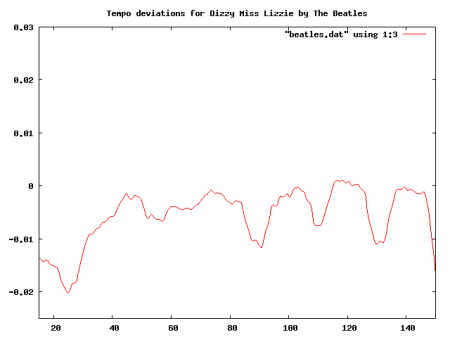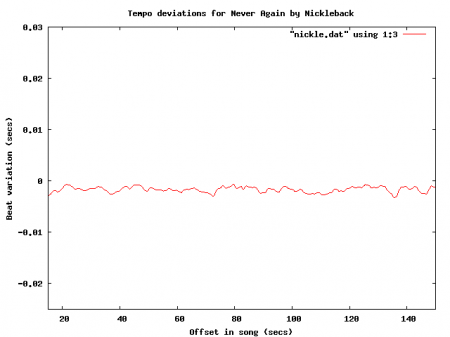I’m coming late to this, but I got a big kick out “In search of the click track“, a recent post on the new-ish blog Music Machinery. By analyzing slight variations in tempo via charts, it seems fairly straight-forward to determine which drummers are employing external cues to maintain a steady beat.
Blogger Paul Lamere starts by examining a track by a drummer who nobody believes used a click track, Ringo Starr:
Compare that to the pattern from a band so awful I wish they weren’t CanCon, Nickleback:
Pretty much indistinguishable from a drum machine. And I think I’d rather try to converse with a Roland DR-670 than with Daniel Adair.
This exercise serves a higher purpose than a game of gotcha. For instance, here is the pattern for John Bonham’s drumming in “Stairway to Heaven”, which slowly and imperceptibly builds intensity. Apparently Jimmy Page once said that the song “speeds up like an adrenaline flow” (note that downward slope indicates shorter beat durations, or a faster tempo).
A fun mystery (for me, anyway) posed in a follow-up post – is Neil Peart using a click-track on “The Enemy Within”, or does the analysis merely confirm the hypothesis that he is indeed a superhuman being from outer space?



I seem to recall from my guitar-geek magazine reading in the 1980s that Rush made no secret about using click tracks. He’s pretty human. The Ayn Rand obsession makes that clear enough, doesn’t it?
Nice one John!
True enough, Rush is so tech-friendly, there’s really no contradiction. I remember a funny interview with Geddy Lee in which he dissed vinyl purists… suggesting the vaunted “warmth” of the medium was just some vestigial (or perhaps nostalgic) longing for qualities best consigned to the rubbish bin of aural history.
The real ringer here is Keith Moon, who had to use a click for the songs with taped backgrounds (“Baba O’Reilly” and “Won’t Get Fooled Again,” among others) but whose time took on a life of its own anyway.
These visualizations are WONDERFUL and remind me why I grow so weary of the tick-tock drum machine rhythms in most pop songs today. I can feel the variations; they release endorphins. The tick-tock just hypnotizes me, and not in a good way.
What a great insight you’ve documented here. Wowser.
I dunno about Rush and the click track … RockBand tunes are quantized and take a look how they did with their own song! http://www.youtube.com/watch?v=btcvSWoQWV0
Great stuff – love the graphics.